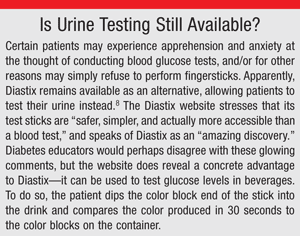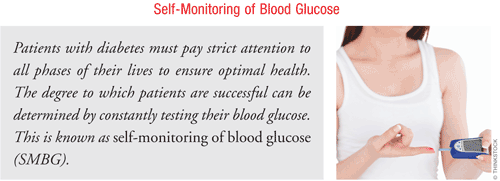US Pharm. 2013;38(10):8-11.
Diabetes mellitus is an endemic medical condition in the United States. The CDC estimates that 8.3% of U.S. citizens are affected, including 18.8 million who are diagnosed and perhaps another 7 million who are not yet diagnosed.1 Diabetes is the seventh leading cause of death in the U.S., a major cause of heart disease and stroke, and the leading cause of renal failure, nontraumatic amputation of the lower limbs, and new cases of blindness among U.S. adults.1
Self-Monitoring of Blood Glucose
Before the advent of blood glucose testing, patients who wished to monitor blood glucose used urine test sticks (e.g., Diastix, Clinistix), urine testing paper (e.g., Tes-Tape), or urine testing tablets (e.g., Clinitest). These tests became outmoded as blood glucose meters were marketed in the late 1970s and thereafter.2 The advent of self-monitoring of blood glucose (SMBG) allowed patients for the first time to exert tight control of their diabetes. They were better able to balance diet, exercise, insulin, and oral medications to keep their blood glucose at safe levels. This tight control helps prevent the deadly sequelae that are inevitable with hyperglycemia and hypoglycemia.

General Tips for Patients
When patients inquire about SMBG, pharmacists can provide a set of general instructions to help them achieve success.3 The first thing a patient should do after purchasing a meter is to read the instruction booklet thoroughly. Many people do not read the instructions before proceeding with use of a newly purchased product. They may be fully able to rely on their intuitive skills to assemble a bookcase or use a new kitchen appliance, as the consequences of misuse in these cases are generally harmless. That is not the case with blood glucose meters. Patients who misuse a blood glucose meter may deliver a large overdose or significant underdose of insulin, either of which can be deadly. Further, being fully familiar with one type of meter does not mean a patient will be able to use a new meter without first reading the manual for it. In addition to reading the instructions thoroughly, patients should also be advised to locate the toll-free number that they can call for further information.
A common question about blood glucose meters concerns test strips and whether one brand of strips can be used in another manufacturer’s meter. Patients may also ask if any other test strips can be used with an older meter when the recommended strips are no longer available. The answers to both of these questions is almost always no.
Other questions about strips are driven by cost considerations. Blood glucose test strips are one of the most expensive components of diabetes care, costing as much as $1.60 each (e.g., FreeStyle InsuLinx Strips).4 Testing five times daily becomes an expensive proposition, costing $8 daily for those strips, or approximately $240 monthly. Thus, patients may ask whether a less expensive brand of strips will work in their machine. Patients even ask whether older leftover strips will work in a newly purchased machine. Again, unless the manufacturer specifically approves this practice, the answer is no.
In an ideal world, manufacturers of blood glucose test strips would cooperate with each other to market a universal test strip that would work in any machine, and all future machines would be made compatible with the universal strip. This would minimize cost to the patient with diabetes. However, this proposal would require monumental and unprecedented effort to implement. Unfortunately, manufacturers work actively to prevent patients from switching strips, as test strips are a high-profit item. When manufacturers market a new glucose monitor, they invariably offer a set of strips custom-made for that machine. This practice locks the patient into purchasing those newer strips, maximizing company profits.
As a result of manufacturers’ practices, pharmacists must advise patients to purchase the strips that are specifically made for their machine. Strips made for older machines must not be used unless the manufacturer’s website advises that they can be used. Switching strips from one manufacturer to another is strictly prohibited. Finally, outdated test strips must be discarded, as the chemical coatings break down and the strips’ results become inaccurate.5
Patients may ask whether testing in sites other than the fingertips (known as alternate site testing) is accurate. According to the FDA, meters that claim to allow patients to take samples from the palm, upper arm, forearm, thigh, or calf can yield accurate results, but should not be used in certain circumstances.6 For instance, patients should use only their fingertips when blood glucose levels are changing rapidly, as alternate sites may give inaccurate results. Other situations when patients should only rely on fingertip testing include when the patient is ill or under stress, has just exercised or eaten, has just administered insulin, cannot reliably detect signs and symptoms of hypoglycemia, believes he or she is hypoglycemic, and/or if the test results do not agree with the patient’s perception of his or her blood glucose level.
As to this latter point, patients should be told to rely on their instincts and physical symptoms.5 If the meter yields results that do not seem right, the patient may have dehydration, high blood osmolarity, a high hematocrit, or incipient shock. Patients should seek medical assistance if they suspect the presence of any of these dangerous conditions.
Choosing a Specific Meter
A detailed discussion of meters currently available is beyond the scope of this article for several reasons. First, at least 80 meters are currently marketed, and they are radically different in the features they offer.4 Even more important, the blood glucose meter market is incredibly dynamic. Manufacturers constantly introduce new versions of their product, each with purported advantages when compared to other meters. Thus, any article discussing meters is outdated shortly after it is published. Despite such diversity, pharmacists can describe various meter options.4
Some meters yield results with sample sizes as small as 0.3 mcL (e.g., FreeStyle Lite, ReliOn Micro), usually suggesting that smaller sizes allow patients to use alternate sites on the body.4 Other meters have an especially large memory, such as the OneTouch Ultra Smart (3,000+ results), Contour USB (2,000 results), and WaveSense Jazz (1,865 results).4
Meters may be particularly useful for those with limited hearing or vision. Some have audio capability (e.g., Prodigy Voice, Embrace), and others have a backlight to enhance readability (e.g., AccuChek Aviva Combo, OneTouch UltraSmart, Precision Xtra).4
The cost of meters may be an issue. Meters range from inexpensive (e.g., $19.99 for a Contour meter) to significantly more expensive (e.g., $149.99 for the Fora D30e/f meter).4 The patient may find a meter useful if it reads blood pressure in addition to blood glucose. This can be found in the Fora D10 meter. Other patients may benefit from the capability to read ketones, as found in the Precision Xtra and Nova Max Plus meters.4
Quality Control
Patients should be urged to read and understand the manufacturer’s booklet section that instructs them on how to ensure that the meter is functioning properly. Whenever a meter is activated, it performs an internal electronic check.6 A problem is signaled by an error code in the display. Patients should be instructed to read the manual, find the meaning of the meters’ various error codes, and see whether instructions are included for fixing the meter when a specific error code appears in the display. Patients should also be urged to call the manufacturer’s toll-free number for advice and not to trust the meter’s results until they are sure the meter is reliable once again.
Some meters require the user to purchase brand-specific control solutions. These solutions should be used whenever the patient opens a new container of test strips, occasionally as the container is being used, whenever a meter has been dropped, and whenever unusual results are observed.6 Patients should purchase new quality control supplies when their expiration dates have passed. Other meters have electronic test strips that induce a signal to confirm that the meter is working as it should.3
As a final quality control method, patients can take their meter to their next medical appointment. The health care provider can observe their technique for accuracy and can order a blood glucose laboratory test to match against the meter’s results to see how closely the meter reflects actual blood glucose.6
The importance of conducting these quality control methods cannot be overestimated. One seldom-mentioned reason is that the expiration date on the manufacturer’s test strip container may not be valid.5 Some companies overestimate the expiration date, so that the strips lose accuracy while seeming to be up-to-date. Further, if the cap of the container is not replaced properly, moisture and ambient air can enter, altering the strips’ accuracy.
Tips to Increase Accuracy
If the patient’s meter seems to yield inaccurate results, there are several tips that can help rectify the situation.5 Patients must be sure to have sufficient blood for the meter. Some meters give an error code with insufficient amounts of blood, but others may not, yielding inaccurate results. The strip must be fully inserted into the meter. If it is not, the display may read high or low. The meter must be kept clean, as readings can be affected if the lens is obstructed by what seems to be only a small amount of dirt, grease, or blood.
If the meter requires users to enter a calibration code, pay close attention so that the correct code is entered, and also be sure to enter that code when first using the new container of strips, or whenever a test is run, as advised by the manufacturer. The meter’s battery may be the problem. Patients should keep several spare batteries on hand and switch them out to ensure accurate readings.
The temperature at which the machine is used could be problematic. Meters that operate reliably at low temperatures include the Sidekick (down to 34˚F), FreeStyle Freedom Lite (40˚F), and Contour Next Link (41˚F).7 Meters that operate reliably at high temperatures include the Precision Xtra (up to 122˚F), ReliOn Ultima (122˚F), Breeze2 (113˚F), and Contour Next EZ (113˚F).7
PATIENT INFORMATION

Importance of Blood Glucose Testing
At one time, patients monitored their glucose status by placing test strips or tablets in a urine sample. These products were unreliable and did not give a good indication of the actual amount of glucose in the blood. Eventually, blood glucose meters became available, and these devices rapidly replaced the old urine tests to become the standard method of glucose testing. In fact, self-monitoring of blood glucose (SMBG) is used by virtually all patients with diabetes today. When it is done correctly, the results are so reliable that patients can use them to adjust their insulin, other medications, diet, and exercise.
Steps in Blood Glucose Testing
The steps patients use in SMBG are fairly simple. Many meters require you to first insert a test strip into a slot in the meter. With others, you simply remove a test strip from its container. Next, you must obtain a blood sample. The most common method is to use an automatic lancet device with a disposable needle. The blood sample must be transferred to the test strip; then the strip is inserted into the meter if this has not already been done. Your blood glucose meter will read and report your blood glucose levels.
Selecting an SMBG System
Manufacturers offer a wide range of glucose meters. Each model has specific advantages when compared to others. The American Diabetes Association provides a useful information handout on the various meters online at http://forecast.diabetes.org/meters-jan2013.
It is critical to note that buying one brand of meter locks you into a specific brand of matching test strips. Manufacturers market strips made for their monitors, and strips made for other devices simply will not work. Even different meters from the same manufacturer often require a different set of strips. You may be able to find generic strips that will work in your meter. Be sure that they specifically mention your meter on their label.
Control Solution
When you choose a blood glucose monitor, ask whether the meter also comes with a control solution. This is usually a small bottle of liquid that you can use to determine whether your meter is working properly. You will put the solution on the test strip in place of your blood sample.
You should use a control solution for the following: 1) to practice the testing process without having to draw a blood sample; 2) to check your meter once weekly; 3) any time you open a new vial of test strips; 4) if you suspect the meter and/or strips are faulty; 5) if your results are repeatedly higher or lower than you expect; 6) if you have dropped or damaged your meter; or 7) if your strips were exposed to an adverse environmental event, such as moisture or excessive heat. You should only use a control solution made for your specific meter, and it should be at room temperature before and during the test.
Remember, if you have questions, Consult Your Pharmacist.
REFERENCES
1. National diabetes fact sheet, 2011. CDC. www.cdc.gov/diabetes/pubs/pdf/ndfs_2011.pdf. Accessed August 21, 2013.
2. Glucose tests: common questions. American Association
for Clinical Chemistry.
http://labtestsonline.org/understanding/analytes/glucose/tab/faq.
Accessed August 21, 2013.
3. Getting up to date on glucose meters. For consumers.
FDA. www.fda.gov/ForConsumers/ConsumerUpdates/ucm049051.htm. Accessed
August 21, 2013.
4. Blood glucose meters: 2013 consumer guide. Diabetes Forecast. January 2013. http://forecast.diabetes.org/files/images/v66n01_p41-47_1.pdf. Accessed August 21, 2013.
5. Useful tips to increase accuracy and reduce errors in
test results from glucose meters. FDA.
www.fda.gov/MedicalDevices/Safety/AlertsandNotices/TipsandArticlesonDeviceSafety/ucm109519.htm.
Accessed August 21, 2013.
6. Blood glucose monitoring devices. FDA.
www.fda.gov/medicaldevices/productsandmedicalprocedures/invitrodiagnostics/glucosetestingdevices/default.htm.
Accessed August 21, 2013.
7. Blood glucose meters 2013. Diabetes Forecast. January 2013. http://forecast.diabetes.org/meters-jan2013. Accessed August 21, 2013.
8. Type 2 diabetes. Diastix. www.diastix.com. Accessed August 31, 2013.
To comment on this article, contact rdavidson@uspharmacist.com.





